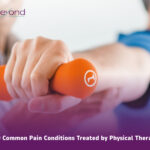Whiplash has to be one of the most common injuries after getting rear-ended in a car accident. What is whiplash? Simply, it is the back and forth motion of the head on the neck. When rear-ended, your head is thrust forward, back and then forward again. As a result, you can experience possible neck pain, muscle spasms or headaches. More severely, a head on collision may cause a loss of consciousness resulting in a concussion.
Motor vehicle accidents resulting in whiplash often send patients to seek physical therapy treatment. I have seen patients suffering from whiplash for months or years after a severe car accident. Interestingly, people do not seek physical therapy immediately after an accident, as the symptoms can settle over time.
When treating whiplash, personally, I take a different approach. Although extremely important to address head and neck mobility, stability, strength and range of motion, it is just as important to address the rib cage, mid spine, pelvis and hips.
The seatbelt, must be taken into consideration. Often times, seat belts can cause more injury than we realize. It locks, thankfully, upon impact. This is essential for safety. However, because of this locking mechanism, it can contribute to the thrusting of the head on neck whiplash effect and can be related to typical whiplash symptoms including nausea, shortness of breath, shoulder pain, chest pain, and dizziness. At the extreme, seatbelt injuries can cause bone fractures, intestinal damage, or internal bleeding. It can also cause a domino effect of other aches and pain in the rib cage, low back, hips, and legs. Sometimes if visible bruising or swelling is not present, we forget about the seatbelt and the possible effects it can have on our body.
If you are getting treatment for whiplash and are not getting better, think about other treatment options. Think about a possible seatbelt injury. If you are getting treatment for your neck but have not had your rib cage, mid back, low back or pelvis addressed it might be time.
Things to keep in mind after a car accident
1. Go to the urgent care or a primary care doctor to get evaluated and to determine whether x-rays, MRI’s or additional testing or imaging needs to take place.
2. Ice. It is a natural anti-inflammatory. Use it for 10 minutes at a time on the area of pain or discomfort. Ice multiple times a day for at least a week after the accident occurred.
3. Contact your local physical therapist. Make sure to get a full body asssessment of your head, neck, and spine. Make to sure to think about the symptoms mentioned above, and anything new that you hadn’t experienced prior to the car accident. All information is worthy of sharing to help heal.
4. If you have been cleared by your doctor and know that you haven’t had any broken bones or torn muscles from a car accident, make sure to keep your body moving. You may not be able to do certain activities that you did prior to the accident, but gentle movements including walking, or cycling on a stationary bike can really help the circulation in your body. This is to prevent your muscles and joints from stiffening up more. Having the guidance of a licensed Doctor of Physical Therapy under these circumstances is ideal.
5. Have faith. It can be stressful having had experienced a car accident. It can affect your daily life, how you work, sleep and move. Keep in mind it takes a minimum of 6-8 weeks after any injury for tissue to heal. Make sure to get your body checked as soon as possible to care of yourself early on. You may go through the ups and downs of the healing process, but overtime your body will improve its mobility, strength and endurance.
















